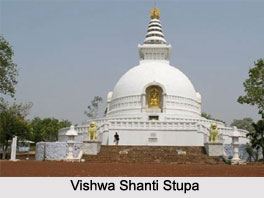 Vishwa Shanti Stupa is situated on Ratnagiri hill, in front of Gridhakuta hill, the favourite residing place of Lord Buddha. It is a major tourist attraction at Rajgir in Bihar. It is a living example of the imagination of Nichidatsu Fujii, the President of Japanese Buddhist Society.
Vishwa Shanti Stupa is situated on Ratnagiri hill, in front of Gridhakuta hill, the favourite residing place of Lord Buddha. It is a major tourist attraction at Rajgir in Bihar. It is a living example of the imagination of Nichidatsu Fujii, the President of Japanese Buddhist Society.
Foundation of Vishwa Shanti Stupa
Nichidatsu Fujii (1885-1985), a Buddhist monk from Japan and founder of the Nipponzan-Myohoji Buddhist sect, set an example to this place a place for World peace. In series of establishing peace pagodas world over he established one such peace pagoda at Rajgir, which is called "Vishwa Shanti Stupa". In 1965 the then President of India laid the foundation stone of this Stupa, which was completed in 4 years and 7 months.
A pagoda is a type of stupa, which provides equality for worship and gathering at one place for common cause that is global peace. The Nipponzan-Myohoji sect has been successful in spreading the views and the doctrines of Gautama Buddha for peace and harmony among people. The stupa what is called as "Japanese Pagoda" is excellent example of oriental style of architecture. Though not all of the Buddhist pagodas in India are built under the guidance of Nichidatsu Fujii, most of them have been built either under his guidance or under his recommendations.
Structure of Vishwa Shanti Stupa
"World Peace Pagoda" or Vishwa Shanti Stupa" at Rajgir is made of spotless white marble and is a remarkable shrine for Buddhists. This Stupa is 129 feet high. On the top of the stupa is a 10 feet high lotus shaped pot. The diameter of the Stupa is 103 feet. Vishwa Shanti Stupa is the tallest peace Pagoda in the world standing tall at 400 meters and houses 4 statues of Lord Buddha on the 4 side-corners of the stupa. The 4 statues on 4 corner-sides of stupa depict the 4 phases of life of Lord Buddha. These statues are made of gold. These statues of Lord Buddha are depicting, birth, enlightenment; teaching and passing away of Lord Buddha are symbolical of Lord Buddha"s teachings and transient life.
How to Reach Vishwa Shanti Stupa
The way to reach this stupa includes an aerial ropeway. The ropeway is operated between Gridhakuta hill and Ratnagiri hill, which covers a distance of 7 km in 8 minutes.



















